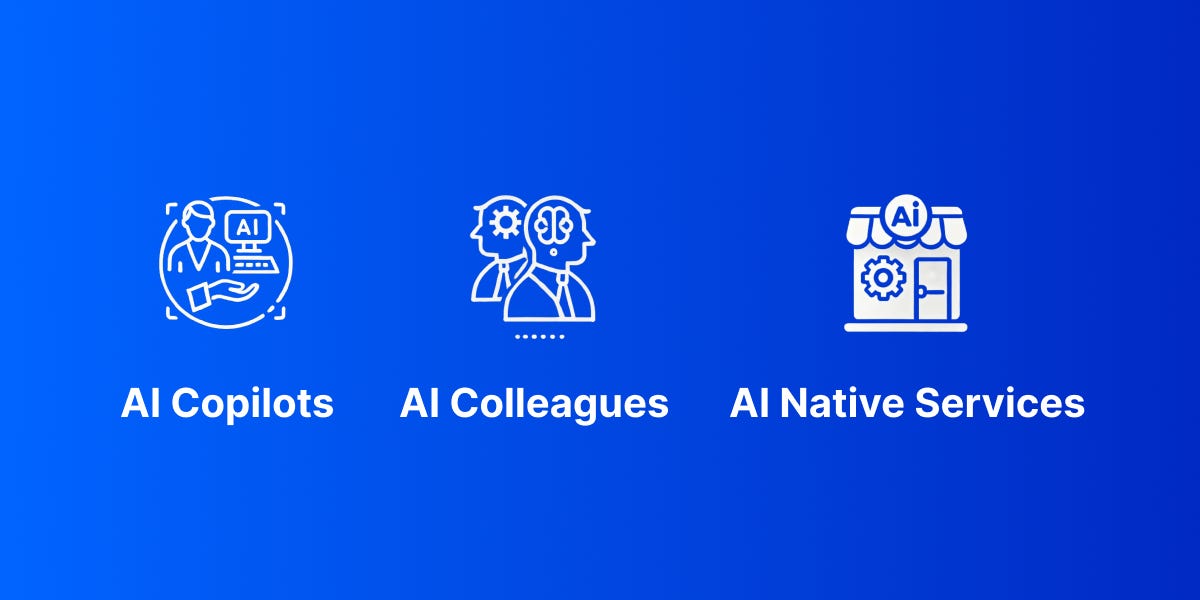Three Archetypes of AI Application Startups

🌈 Abstract
The article discusses the three main archetypes of AI applications that have emerged in the technology industry over the past year: AI copilots, AI colleagues, and AI-native services. It provides examples and explains the key characteristics of each archetype.
🙋 Q&A
[01] AI Copilots
1. What are AI copilots and how do they help workers?
- AI copilots act as supercharged assistants that enhance productivity by supporting users in various tasks.
- They help people get up to speed faster, execute core tasks quicker and better, and assist in spending less time on mundane tasks.
- Examples include GitHub Copilot, Casetext, and Harvey which are specialized copilots for developers, legal professionals, and others.
- Incumbents like Salesforce, Adobe, Microsoft, and Google are also adding copilots to their products.
2. How are some companies building internal AI copilots for their employees?
- Some companies are building internal copilots for their employees, such as Lilli, an internal copilot built for consultants within McKinsey to help with tasks like synthesizing transcripts, researching their knowledge library, and generating artifacts.
[02] AI Colleagues
1. How do AI colleagues differ from AI copilots?
- AI colleagues go a step further than AI copilots by acting as proactive, autonomous agents that can take on more complex, decision-making tasks themselves.
- They are designed to work alongside human teams, seamlessly integrating into the workflow and often acting autonomously to manage specific tasks.
2. What are some examples of AI colleagues?
- Devin, which is billed as the world's first AI software engineer that companies can "hire" to work alongside human engineers.
- AI SDR (sales development representative) agents like 11x and AiSDR that can autonomously identify leads, research accounts, personalize emails, and book meetings.
- Autonomous support agents like Sierra and Decagon that can resolve a high percentage of support queries autonomously.
- Slang, an AI-powered receptionist that can handle inbound calls, schedule appointments, and answer questions for businesses.
3. Where do AI colleagues work well?
- AI colleagues are particularly valuable in roles where a high volume of decisions are required and the processes are generally quite repeatable and well-understood, or the cost of a mistake is generally low.
- They enhance team capabilities by taking over a large volume of workflows/decisions, allowing human colleagues to focus on more complicated work.
[03] AI-Native Services
1. What are AI-native services and how do they differ from traditional service firms?
- AI-native services startups are "full-stack businesses" that solve problems end-to-end for customers, managing all the complexity and interplay between technology and labor themselves.
- They compete with traditional service firms, agencies, and outsourcing firms by providing the service at equal or better quality but with much higher automation and lower costs.
2. What are some examples of AI-native services?
- Alma and Marble, which provide legal services in areas like immigration and family law.
- Pilot and Gelt, which offer bookkeeping, CFO, and tax services.
- Isoform, which provides custom integrations as a service.
3. What are some key points about the AI-native services approach?
- While these startups may be more scalable or have better margins than their service counterparts, they are still essentially service firms and will likely be valued in similar ways on EBITDA multiples.
- Some AI-native services companies may use acquisitions as a go-to-market strategy, either by building out the technology first or by acquiring an incumbent and then automating and improving margins.
Shared by Daniel Chen ·
© 2024 NewMotor Inc.